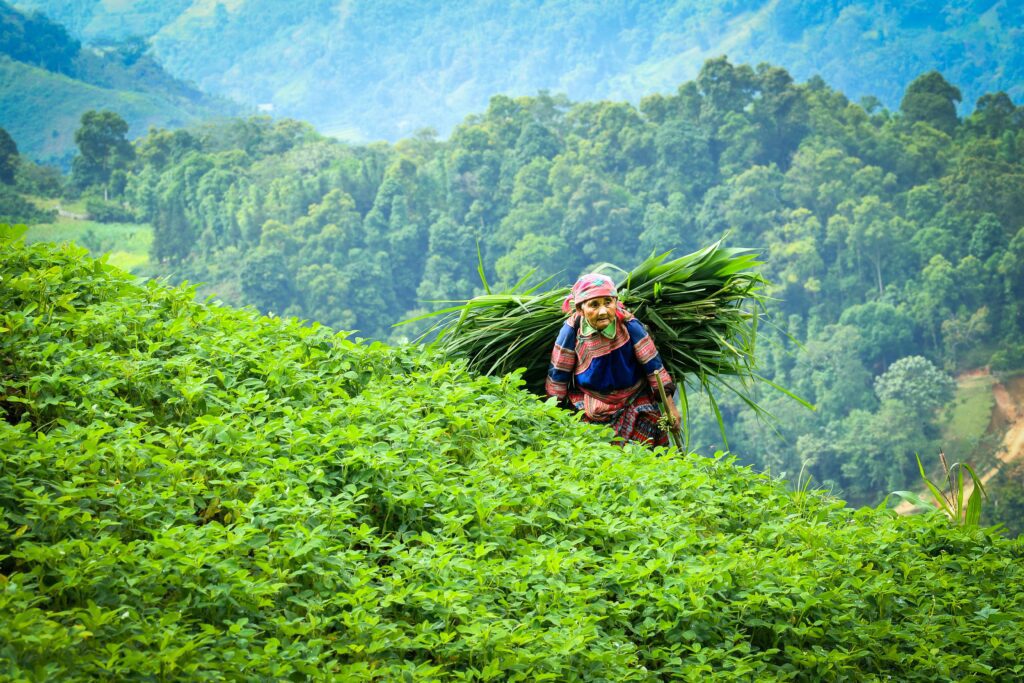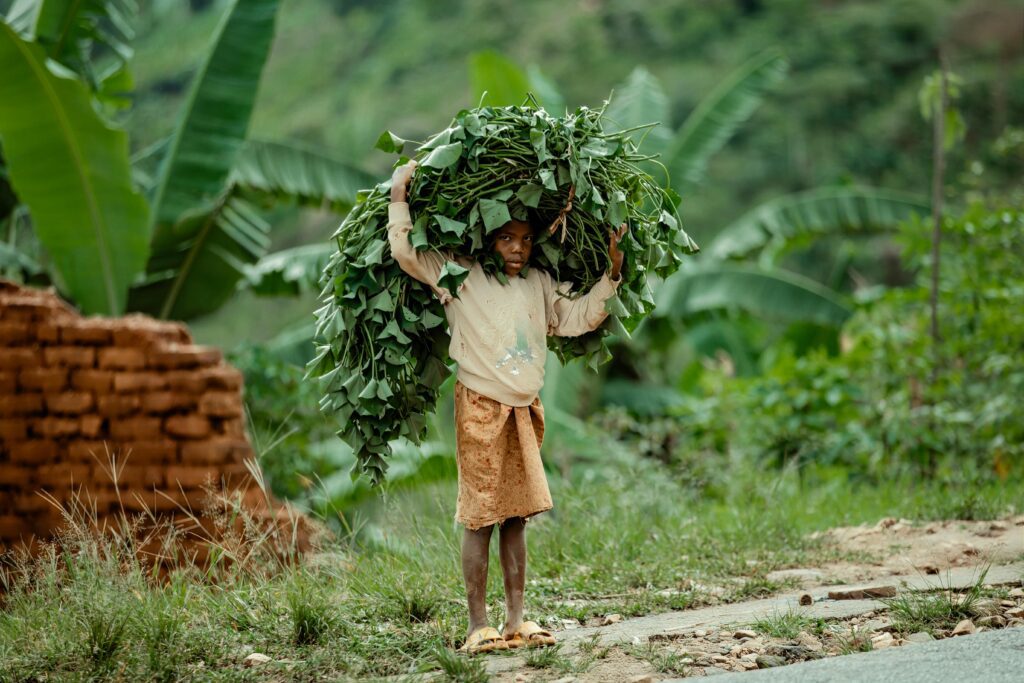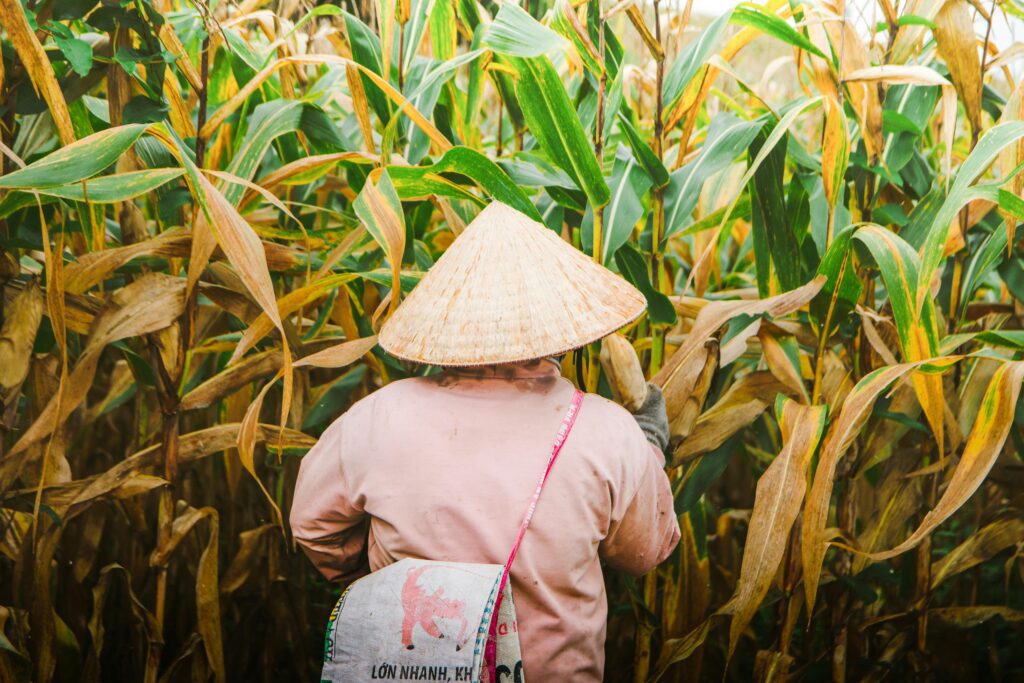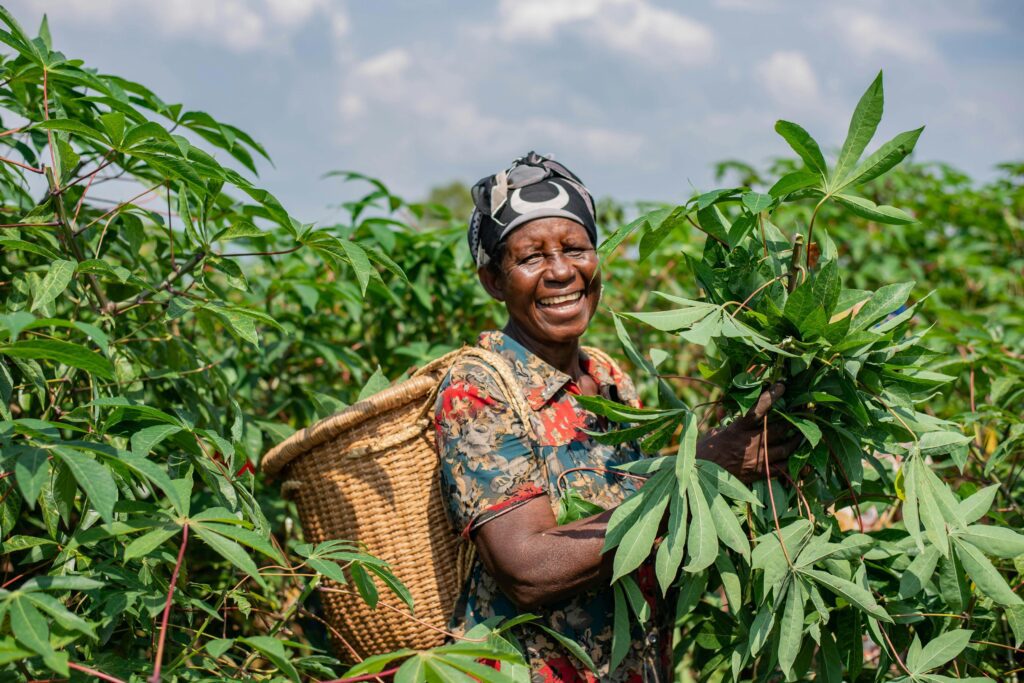Table of Contents
Introduction
Subsistence farming is amongst the oldest and most primitive agriculture that human beings have ever witnessed. It is a survival-based life on the basis of community and autonomy.
Subsistence farming is simply a traditional system of farming in which farmers grow foods mainly for their own use and not to sell on the market. This approach guarantees that one family generates as much food as it requires to feed the household with minimal or no excess to exchange.
The definition of subsistence agriculture is important in comprehending how effective small-scale practices enable rural families worldwide to maintain their lifestyle.
Subsistence agriculture is nonetheless a prevalent form of food production in the majority of developing countries, particularly in African, Asian, and Latin American nations. It sustains rural livelihoods, keeps alive traditional farming, and preserves an essential relationship between people and nature.
The producers who make this system possible usually base themselves on old-fashioned tools, natural rainfalls, and traditional farming skills accumulated over several generations. These systems are not looking advanced but are resilient and resourceful.
The concept of subsistence agriculture goes beyond the mere production of food—subsistence agriculture speaks of strength, resilience, and harmony with the environment.
Subsistence farming is interested in the production of on-hand subsistence for a family or community, as opposed to commercial agriculture with a focus on profit maximization.
For instance, the peasant Indian farmer will plant rice, maize, and vegetables on the farm to supply the family with food all year long through organic compost and reuse of seeds from past harvests. This organic method provides food security and autonomy under limited resources.
And now, with increasing worldwide challenges such as climate change, soil degradation, and famine, principles of subsistence agriculture are becoming increasingly important. It indicates the way in which small-scale farmers can tap local expertise and sustainable techniques to preserve soil fertility and biodiversity.
Subsistence agriculture meaning knowledge also assists policymakers, researchers, and students to create improved support systems for agriculture that preserve traditional livelihoods and offer new innovations for increased productivity and resilience.
In this article, we will learn about five powerful lessons in subsistence farming that will make you knowledgeable about its practice, advantages, disadvantages, and contemporary relevance.

As an agriculture student, inquiring reader, or policymaker, this detailed article aims to provide you with an overall idea of how subsistence agriculture continues to influence the global food systems.
From ancient heritage to contemporary relevance, subsistence farming is a corner stone of agricultural sustainability and human survival.
Benefits of Subsistence Farming
1. Guarantees Household Food Security
Household and small society food security in the immediate future is the largest benefit of subsistence farming. Farmers produce crops and rear livestock under this type of farming primarily to provide for their families.
The autonomous practice guarantees that even during economic downtimes or market instability, the home will never run out of food on the table. For instance, a subsistence farmer may plant rice, vegetables, and pulses and keep some goats or chicken for milk and meat.
The crops meet the family’s nutritional requirements and lessens reliance on other sources of food. Subsistence agriculture meaning concept also shows how subsistence farming plays a crucial role in areas where government or market assistance is not available.
By producing food on their own, farmers are independent and shielded from inflation and famine.
2. Encourages Sustainable and Environmentally Friendly Practices
Subsistence farming also has a major advantage of naturally being compatible with sustainability. Unlike commercial farming, which has the tendency to rely on chemical fertilizers and mass mechanization, subsistence farming relies on organic manure, crop rotation, and natural pest control.
These methods ensure soil fertility, lower environmental pollution, and conserve biodiversity. Subsistence farmers use the ancient methods like composting, intercropping, and rain-fed irrigation — all of which involve the least environmental degradation.
The approach also encourages maintaining traditional varieties of crops that are more robust to the local ecology. The concept of subsistence farming hence becomes ecopreservation, showing how straightforward, local practices maintain planetary well-being and nourish families.
3. Maintains Traditional Knowledge and Cultural Heritage
Subsistence agriculture is also deeply ingrained in the social and cultural existence of the majority of rural communities. It passes down centuries of agricultural tradition, traditional seed-saving practices, and local knowledge about weather patterns, soil types, and crops.
Subsistence agriculture meaning enables us to understand that this process is not merely about producing food — it’s about preserving heritage. In rural and tribal society, agriculture can be connected with festivals, rituals, and seasons.
For example, the local farmers may celebrate seasons of planting and harvest in accordance with local customs that appreciate the gratitude to the land. Such a connection with culture and nature reinforces community cohesion as well as guarantees the passing down of precious wisdom to generations to come.
4. Minimizes Dependence on Market Forces
Profits from commercial farming are subject to vagaries of market prices, the price of fuel, and exports abroad. Subsistence farming enables the small farmer to be shielded largely from all such external factors.
Because much of the produce is sold locally, the farmer does not need to bother himself with fluctuation in the price of the crop or transport cost. This self-reliance is particularly important during periods of economic downturn or inflation.
Subsistence farming allows the rural family to sustain itself without depending too much on outside income or government subsidy. This autonomous method also shields them from debt traps that generally get small-scale farmers because they use loans to finance business farming.
The subsistence farming definition here is self-sufficiency — the ability to live and prosper for oneself.
5. Fosters Community Solidarity and Mutual Support
Another one of the largely underutilized advantages of subsistence farming is how it creates the strength of cooperation and solidarity among rural communities. As such farms are typically family-owned, all of them from the children to the old people and everyone in between are involved in the farm cycle.
Adjacent families tend to coordinate their labor, equipment, and even seeds at planting or harvest time. This cooperative mindset boosts productivity, social trust, and solidarity in the rural economy.
In every location, subsistence farming is a source of community survival where the participants unite to deal with adversity like drought or infestation. The social significance of subsistence agriculture represents the way it improves relationships, stimulates equality, and diminishes isolation in rural communities.
6. Encourages Crop Diversity and Permanence
While commercial monoculture systems are dedicated to a sole cash crop, subsistence agriculture encourages diversified and mixed farming. A farm may have grains, legumes, vegetables, and fruits, with small animals.
All these types assist in keeping the ecosystem in balance and guarding farmers against complete loss in the event that they are infested by pests or due to climatic change. Crop diversification is thus preceded by subsistence agriculture to enhance food security and provide nutritional diversity to households.
For example, in the event of a drought destroying a maize crop, millet or beans are still consumable. This capacity is perhaps the most useful virtue of subsistence agriculture, demonstrating how traditional frameworks handle uncertainty in the environment with relative ease.
The definition of subsistence agriculture in this regard is obvious — survival by diversity.
7. Unites Rural Economy and Employment
While subsistence agriculture exists mainly for household consumption, it still plays an important part in a strong rural economy. It employs millions of smallholder farmers, landless farm workers, and relatives throughout the world.
In the absence of industrial or service work opportunities, subsistence farming provides a stable living. Further, sporadic surplus yields can be marketed in nearby marketplaces, which earn small but vital incomes maintaining rural homes.

Understanding subsistence agriculture definition from an economic point of view assists in revealing its contribution to poverty alleviation and food distribution in developing countries. By offering regular employment, it activates the rural masses and takes the burden off the cities due to migration.
Techniques of Subsistence Farming
1. Shifting Cultivation
Shifting cultivation, or “slash and burn” agriculture, is most likely the most traditional and oldest method of subsistence farming. In this process, the farmer clears an area by slashing and burning crops to produce ash-rich soil.
They sow on the ground for a number of years until the fertility of the land starts to decline. After land fertility begins to decline, the farmer proceeds to another area of land and does the same. This process has the effect of allowing previously cultivated ground time to naturally rejuvenate.
While contemporary environmental policies frown upon slash and burn on a massive scale, small-scale shifting cultivation is still a vital component of subsistence agriculture in countries such as Northeast India, Southeast Asia, and parts of Africa.
To grasp the vocabulary of subsistence agriculture here is to realize that this method is not wasteful—it’s an age-old coping strategy to limited resources and land, created to optimize human needs against nature’s cycle.
2. Intensive Subsistence Farming
Intensive subsistence farming is practiced in heavily populated areas where each square inch of land has to be farmed up to its capacity. The farmers plant small plots with great care, utilizing irrigation, manure, and human power in place of machinery.
Rice, wheat, and vegetables are cultivated by intensive systems of high yields per hectare. For instance, paddy farming under subsistence agriculture in India, China, and Bangladesh utilizes canal or rainwater harvesting network water to provide food at all times to family members.
The approach of subsistence agriculture definition illustrates perseverance and hard work because farmers put so much labor by hand to sustain their livelihood. These farmers possess limited pieces of land but realize astronomical returns through hard work, indigenous knowledge, and effective use of resources.
3. Nomadic Herding
Nomadic herding, also referred to as pastoralism, is another famous method under subsistence agriculture, commonly practiced in arid and semi-arid areas. In this, people keep moving from one location to another along with their cattle, goats, sheep, or camels in pursuit of pasture and water.
The main reason for adopting this subsistence style of farming is to have a steady source of food in the form of meat, milk, hides, and wool. The East African Maasai and other Central Asian people, for instance, have traditionally depended on nomadic herding.
The lifestyle is a reflection of the profound subsistence agriculture meaning—aligning human life with nature environments. Mobile herders build a good comprehension of husbandry of animals, weather patterns, and regenerative grazing that maintains fragile ecosystems even in bad times.
4. Mixed Farming
Mixed farming is a catch-all and productive practice in subsistence farming in which plants and animals are cultivated on the same field. This type of agriculture has a natural balance — animals provide manure that enriches the soil, and crop residues may serve as cattle feed.
It is a cycle that is closed and reduces wastage, as well as boosting productivity. For example, the subsistence farmer may plant cereals such as wheat or maize and at the same time keep poultry or cattle.
Subsistence farming integrated practice guarantees variety in food and other incomes from dairy, eggs, or meat. The subsistence farming definition here focuses on interdependence — plants and animals complement one another, creating a self-sustaining cycle that enhances food security and resourcefulness.
5. Terrace Farming
Subsistence farmers on mountain or hill land employ terrace farming — a thrifty method that inhibits soil erosion and retains water. In this technique, sloping lands are converted into a series of stepped-terraces on which crops can be grown on flat lands.
It is most prevalent in the Himalayas, Southeast Asia, and a large part of South America. Terrace farming allows farmers to grow rice, potatoes, and vegetables on land otherwise useless. With the construction of retaining walls and channels, water is provided evenly and wastage is reduced.
The sense of innovation here in subsistence farming is the ability of farmers to transform geographical obstacles into productive areas through application of determination and creativity.
6. Crop Rotation and Intercropping
If the land is to be fertile and not overrun with insects, subsistence farming tends to employ the use of conventional means such as crop rotation and intercropping. In crop rotation, various crops are sown on a single field in successive seasons — e.g., legumes and then cereals — to replenish the soil naturally with nutrients.
In intercropping, several crops are planted together on one field at the same time to optimize land and resources. These methods are indicative of the sustainable character of subsistence farming, where nature balance is given equal importance to food output.
Subsistence farmers who understand the subsistence agriculture meaning realize that a healthy soil is equivalent to long-term productivity and therefore do not overexploit and instead farm in tandem with nature to maintain yields year after year.
7. Rain-Fed and Manual Irrigation Systems
Most subsistence farmers rely on natural rainfall alone for irrigation. But where rainfall is uncertain, they construct small wells, ponds, or canals to divert and redistribute the water by hand.
In contrast with commercial irrigation systems, these are cheap, ecologically benign, and locally focused subsistence farming methods of handling local water. Farmers tend to collaborate in sharing water resources, maintaining open canals, and sharing the water equally.

The term subsistence agriculture is also easily understandable here as a culture of sharing and conserving resources — using available water judiciously to feed crops without harming the ecosystem.
These traditional irrigation systems also avoid drought stress and maintain food security even in summer seasons.
8. Indigenous Seeds and Organic Fertilizers
The other characteristic of subsistence agriculture is that the farmers utilize stored and domesticated local seeds. Traditional seeds are more sustainable and tolerant compared to hybrid seeds that depend on chemicals.
Organic manures like animal excreta, compost, and green leaves are also used by farmers to keep the land fertile. Organic methods are cost-effective and maintain sustainable soil quality, which keeps subsistence agriculture cheap and eco-friendly.
By adopting indigenous biodiversity, subsistence farmers teach us the spirit of subsistence agriculture — responsible resource management of nature with the ability to support their families’ food needs.
This natural process is being taken note of all over the world as industrial agriculture reaches out to more sustainable and ecological production based on traditional agriculture.
Challenges of Subsistence Farming
1. Limited Access to Modern Technology
One of the largest obstacles for subsistence farming communities is limited exposure to contemporary techniques of agriculture. Commercial farms, due to their ability to purchase tractors, automated irrigation systems, and advanced machinery, have access to high-quality technology.
Subsistence farmers, on the other hand, continue to use simple manual tools and animal power. This limitation inhibits productivity and makes agriculture more labor-intensive, impacting output as well as efficiency.
For example, mechanized planting and harvesting of crops can take weeks, while mechanical planting and harvesting can minimize the time. Use of the term subsistence agriculture here captures the isolation between past and current farm inventions.
Farmers are unable to enjoy maximum land potential without inexpensive technology, and they are susceptible to food shortage and income volatility.
2. Climate Change Vulnerability
Subsistence agriculture relies heavily on weather, and therefore it is highly exposed to climate change. Inconsistent precipitation, dryness, floods, and increased temperature all have direct impacts on agricultural output.
For instance, a single smallholder farmer with rain-fed rice farming will experience total crop failure under a condition of drought. Since subsistence farming lacks irrigation systems or crop insurance, bad weather can be calamitous to the availability of food.
A definition of subsistence agriculture in this regard emphasizes the vulnerability of these systems. Climate uncertainty not only impacts household food security but also undermines the long-term sustainability of conventional farming practices.
3. Fragmented Farm Land and Small Farm Sizes
Beyond the problem of land use constraints, a second problem subsistence farmers contend with is farm size. The majority of the farmers possess extremely small holdings, usually scattered in different locations as a result of inheritances subdivision.
Such dispersed and small holdings are barriers to the application of advanced farming methods or economies of scale. With all square meters being precious in subsistence agriculture, scarce land limits crops’ diversity, yields, and surplus to market sales.
Subsistence farming depicts the challenge of keeping families on limited resources. Limited farm size also inhibits investment in fixed capital, including water storage or soil conservation facilities, and leads to farmers relying on nature.
4. Inadequate Access to Quality Seeds and Inputs
Subsistence agriculture’s perpetual concern is access to quality seeds, fertilizers, and pest management. Most farmers still employ traditional seeds, which, even though hardy, may yield lower returns compared to improved or hybrid varieties.
Minimal exposure to organic manures, irrigation equipment, or pest control interventions still curtails production. In subsistence agriculture, the lack of access to required inputs may result in low yields and nutritional shortages within households.
Subsistence agriculture in this context refers to the need for smooth modernization — the addition of better inputs without disturbing traditional techniques or the integrity of local environments.
5. Low Income and Monetary Restraints
As subsistence farming is mainly for household consumption, potential for earning a steady income is restricted. There is little surplus to sell, and local market prices are unpredictable, providing irregular returns.
Such economic limitations cannot enable farmers to invest in preparation of land, machines, or sending their children to school. In most instances, subsistence farmers households are ensnared in poverty traps and utilize petty loans or traditional credit systems to sustain basic needs.
This foregoing definition of subsistence agriculture meaning captures the economic vulnerability that accompanies subsistence farming. Lacking support, farmers cannot expand output or enhance living standards, thus perpetuating poverty from one generation to another.
6. Stress and Degradation of the Environment
Serial cropping on small holdings with poor soil management can eventually result in soil degradation. Subsistence farmers may not have the means to adopt sophisticated techniques of soil fertility or soil erosion control, and therefore their soil is vulnerable to nutrient loss.
Deforestation, grazing, and prolonged rains are environmental stressors that further affect the health of soil. Subsistence agriculture decreases yield and undermines household food security through poor soils directly.

Subsistence agriculture here is defined as a depiction of the delicate balance farmers have to walk between getting as much in the short run as possible and keeping land so as to ensure long-run sustainability.
7. Restricted Access to Agricultural Education and Extension Services
Most subsistence farming communities lack access to adequate agricultural education and extension services. Farmers may not have better-desired crop varieties, pest control management, and superior farming techniques that can drive productivity if they are not guided effectively.
Subsistence farming survives by indigenous knowledge, but today combining it with science can make a big difference. The subsistence farming definition in this challenge discusses bridging knowledge gaps.
Inadequate training not only impacts the current harvests but also discourages the use of sustainable ways that may enhance farming so that it becomes sustainable and profitable in the future.
Solutions to Overcome Challenges in Subsistence Farming
1. Use of Low-Cost Modern Technology
The use of low-cost modern technology is a good solution to the improvement of subsistence farming. Although full mechanization might not be feasible for farmers on a small scale, low-cost equipment like hand seeders, mini water pumps, and solar-powered water systems can indeed play a huge role.
Through a wise mix-up of traditional knowledge and innovations, subsistence farming can be made more productive without losing its sustainability. For instance, irrigation using a tiny treadle pump enables farmers to irrigate crops during drought, increasing yields while saving energy.
Understanding subsistence agriculture meaning in this sense shows how plain technology integration can play a huge role in promoting food security and income.
2. Climate-Resilient Farming Practices
In the fight against the effects of climate change, subsistence farmers have the capability of embracing climate-resilient practices. These are like growing crops that are resistant to drought, sowing varieties of crops that mature early, and using rainwater harvesting equipment.
Methods such as mulching and contour planting can conserve soil moisture and prevent soil erosion. These are a necessity in subsistence farming so that regardless of weather vagaries, there shall be regular harvests.
Farmers who know the subsistence agriculture definition see that climate change adaptation is not a choice, but a requirement, if they want to survive.
For example, people in African semi-arid areas have effectively used small ponds and water conservation, which enable them to support crops even in drought times.
3. Land Use Efficiency and Crop Diversification
Maximizing the productivity of small parcels of land is the most important element for yield maximization in subsistence farming. Crop rotation, intercropping, and polyculture enhance soil health, suppress pest infestation, and yield multiple food sources.
Through crop diversification, farmers obtain nutritional diversity as well as a buffer against complete crop failure. Even the little land can sustain many crops and a few animals in subsistence agriculture, and that makes the system sustainable and balanced.
Realizing the definition of subsistence agriculture in this method accentuates the spirit of smart land management, where every square inch of farm land is securing food and maintaining ecosystem balance at the same time.
4. Better Access to Quality Seeds and Inputs
Providing subsistence farmers with improved access to quality seeds, organic fertilizers, and natural pest control methods is another potential solution. Seed banks, training programs, and microcredit schemes may be provided by governments and NGOs for farmers to purchase improved inputs.
Through the implementation of the use of better varieties of crops that are adapted to environmental conditions, subsistence farmers can raise output and the nutritional quality of their crops.
The concept of subsistence farming under this instance is one of resilience — the mix of old knowledge with improved inputs affords small-scale farms the ability to support families without compromising on soil sustainability and health.
5. Community-Based Irrigation and Water Management
Water shortage could be a significant problem for subsistence agriculture, but common sense provides optimism. People can create community-based irrigation systems, small check dams, or water-sharing contracts in order to provide equal access to water.
For subsistence agriculture, these projects not only augment plant growth but also provide other bonding for people in communities.
Seeing the definition of subsistence agriculture in water management emphasizes collaboration — whenever farmers work together, they are able to break down obstacles that are not breakable if they were to work separately. They lower reliance on wayward rain and increase food security in dry regions.
6. Access to Education and Agricultural Extension Services
Extension and education for subsistence farmers are important for sustainable growth in the long term. Training intervention can institutionalize sustainable agriculture practices, economic management, conservation of soil, and pest management.
Integration of indigenous knowledge and modern agricultural science ensures greater productivity and sustainability for adopting farmers in subsistence agriculture.
Defining subsistence agriculture here is emphasis on empowerment — educated farmers are more capable of decision-making, coping with problems, and innovating while maintaining the tradition in agriculture.
7. Government Assistance and Microfinance
Government assistance in the form of microloans, subsidies, or grants facilitates the investment of subsistence farmers in irrigation systems, machinery, and seeds.
Government measures for insurance protection for crop destruction, training camps, and market access further increase resilience of subsistence farming.
Subsistence agriculture definition in this context denotes empowerment by support — in the event that farmers are supported by finances and policy, they can provide food security, enhance livelihoods, and gradually scale up surplus production to adjacent markets.

Such measures ensure traditional farming is able to succeed in a contemporary environment without compromising on sustainability and family-centered production objectives.
FAQs on Subsistence Farming
1. What is the definition of subsistence agriculture?
Subsistence agriculture definition is a form of agriculture in which crops and animals are grown to be used mainly by the farmer’s family instead of commercially. The farm system focuses on independence with low external inputs and the use of local knowledge and natural capital.
Subsistence agriculture guarantees food security, the maintenance of traditional production methods, and environmental integrity. Although it is not profitable to a great extent, the term subsistence agriculture illustrates the way it is essential to rural livelihood and the sustainability of the ecosystem balance.
2. What are the advantages of subsistence farming to small-scale producers?
Subsistence agriculture is helpful for small-scale farmers in various ways. It ensures family food security directly, decreases reliance on volatile market prices, and ensures sustainable farm output.
In subsistence farming, the farmers adopt organic manures, native seeds, and traditional ways of farming, which maintain soil fertility as well as biological diversity. The system also promotes collaboration between people, reinforces the local economies, and conserves cultural heritage.
Understanding the meaning of subsistence agriculture helps us realize how all these advantages are blended together to help families as well as rural communities.
3. What are the key practices used in subsistence farming?
A few of the old practices are generally adopted in subsistence farming, such as shifting cultivation, terrace farming, mixed farming, crop rotation, intercropping, and nomadic herding. The practices enable efficient use of resources and the optimization of food production for household consumption.
For instance, mixed farming, where crops and animals are utilized in combination to attain a closed system in which the animals supply manure to manure the soil and the crops supply feed for the animals.
Knowledge of subsistence agriculture definition allows us to understand the reason why such ancient methods are valuable and efficient in enhancing small-scale farmers globally.
4. What are some challenges that subsistence farmers experience?
Subsistence farmers experience numerous challenges, ranging from inadequate access to modern technology, limited land areas, lack of sufficient funds, unpredictability of weather, soil erosion, and insufficient proper education or extension services.
These are hindrances that lower productivity, compromise food security, and render surplus income difficult to achieve. Subsistence farmers have to depend solely on traditional knowledge and nature, which may prove to be inadequate in times of hardship.
The theory of subsistence farming identifies the narrow margin that separates the farmers between survival, sustainability, and adaptation in an ever-changing world.
5. How are challenges to subsistence farming addressed?
Subsistence farming challenges can be met with low-cost adoption of technology, climate-resilient agriculture, crop diversification, improved seed quality access, community-based irrigation, education, and microfinance.
Subsistence agriculture can be made more productive, sustainable, and resilient by combining traditional knowledge and innovative solutions.
Grasping the concept of subsistence agriculture here highlights empowerment — farmers with resources, information, and cooperative networks can manage their homes, ensure the environment, and incrementally enhance livelihoods.
Conclusion
Subsistence farming is still the most vital farm practice that binds dozens of families to their heritage, land, and food. With the concept of subsistence agriculture, we realize that it is not simply planting crops but keeping life going, upholding tradition, and balancing nature.
From family food security to sustainable development, subsistence agriculture is a vital component in sustaining rural societies globally. The advantages of subsistence farming are diverse.
It ensures nutrition, promotes biodiversity, minimizes dependence on the market, and assists in sustaining tight community relationships. Methods like shifting cultivation, mixed farming, terrace farming, and crop rotation attest to the resourcefulness of farmers in coping with limited inputs in an attempt to maximize yield.
Notwithstanding adversity from such sources as constrained technology, fiscal limitations, climatic exposure, and small farms, measures like cash technology uptake, climate resilient farming, diversification of crops, and peer support have windows of opportunity for enduring enhancement.
To policymakers, farmers, and students alike, understanding subsistence farming is key for planning as one prepares interventions that strengthen rural communities in terms of age-old knowledge.
It demonstrates that new development does not always have to substitute traditional wisdom but can stride along with it to provide food security, sustainability, and resilience.
Subsistence agriculture is defined as a framework where survival, self-sufficiency, and compatibility with nature blend to provide a sustainable lifestyle. For agriculture and rural development readers, adopting the wisdom of subsistence agriculture can revolutionize your life.
By favoring traditional farmers, advocating sustainable approaches, and increasing access to information and inputs, we can guarantee that this ancient practice of farming is kept alive and flourishes.
As a researcher, student, or prospective farmer, understanding subsistence agriculture enables you to be part of shaping a future in which food security, sustainability, and community prosperity are compatible.
